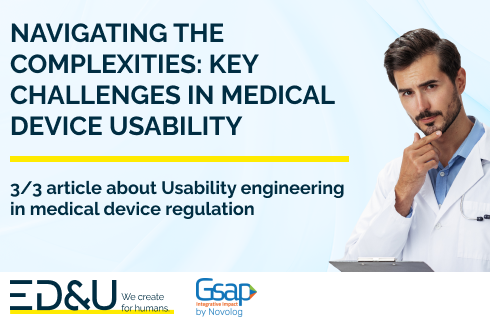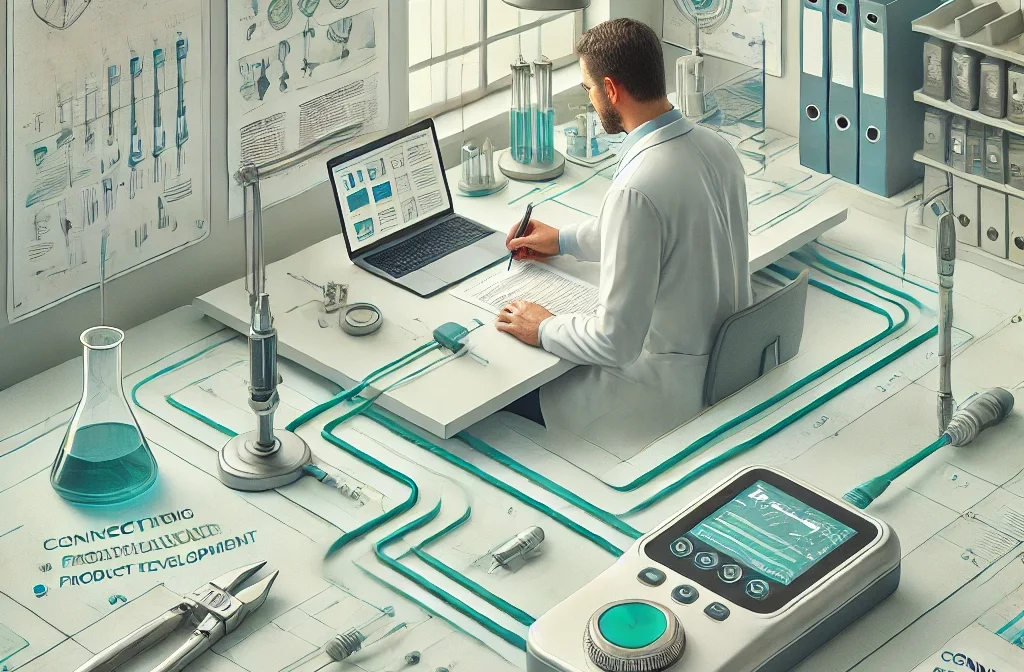Navigating the Complexities: Key Challenges in Medical Device Usability
August 18, 2024 Gsap and ED&U TeamNavigating the Complexities: Key Challenges in Medical Device Usability
August 18, 2024
Gsap and ED&U Team
In the rapidly evolving field of medical technology, achieving optimal usability remains a significant challenge. As we strive to create devices that are both technologically advanced and user-friendly, several key obstacles emerge. Understanding these challenges is crucial for medical device manufacturers and usability engineers to develop effective solutions.
1. Accommodating Diverse User Needs
The medical device landscape is unique in its wide range of users, from highly trained healthcare professionals to patients with varying levels of technical expertise and physical capabilities. This diversity presents a complex challenge:
- Healthcare Professionals: Devices must cater to specialists who require advanced functionalities without compromising efficiency.
- Patients: Home-use devices need to be simple enough for users who may have limited technical skills or physical limitations.
- Assistive Personnel: Often overlooked, this group includes various crucial roles that must be considered in the design process: Hospital Support Staff, Technicians, Home Caregivers, and Emergency Responders. Many of these users might interact with devices in high-stress situations, adding another layer of usability challenges.
- Cultural and Linguistic Factors: In a global market, devices must be intuitive across different cultures and languages.
2. Balancing Complexity and Simplicity
Modern medical devices often incorporate sophisticated technologies and multiple functions. The challenge lies in presenting these capabilities in a user-friendly manner:
- Feature Overload: Adding too many features can overwhelm users and increase the risk of errors.
- Oversimplification: Stripping down functionality to improve usability may limit the device's effectiveness.
- Critical vs. Non-critical Functions: Determining which functions should be easily accessible and which can be nested in menus.
3. Seamless Integration with Existing Workflows
Healthcare environments are complex ecosystems with established procedures. New devices must fit into these existing workflows without causing disruption:
- Interoperability: Ensuring new devices can communicate effectively with existing systems.
- Training Requirements: Minimizing the learning curve for new devices to avoid workflow interruptions.
- Physical Integration: Considering how the device fits physically within the healthcare setting.
- Organizational Effects: Understanding and addressing the broader impacts on organizational structure, job roles, and processes. New devices may necessitate changes in staff responsibilities, and departmental interactions, or even create new roles, potentially leading to resistance or requiring careful change management.
4. Regulatory Compliance vs. Innovation
While not mentioned in the original paragraph, this is a significant challenge worth addressing:
- Stringent Regulations: Adhering to FDA and other regulatory guidelines can sometimes limit design choices.
- Documenting Usability: The need for extensive documentation of the usability engineering process can be resource-intensive.
- Balancing Innovation: Ensuring compliance while still pushing the boundaries of technological advancement.
5. Evolving Technology and User Expectations
As technology rapidly advances, user expectations for intuitive interfaces grow:
- Keeping Pace: Ensuring medical devices match the usability standards set by consumer electronics.
- Future-Proofing: Designing devices that can adapt to future technological advancements.
- Generational Differences: Catering to both tech-savvy younger generations and older users who may be less comfortable with technology.
6. Regulatory Compliance vs. Innovation
- Stringent Regulations: Adhering to FDA and other regulatory guidelines can sometimes limit design choices.
- Documenting Usability: The need for extensive documentation of the usability engineering process can be resource-intensive.
- Balancing Innovation: Ensuring compliance while still pushing the boundaries of technological advancement.
- Unbiased Summative Validation: Securing an independent, external team to perform summative validation can be challenging. This step is crucial for regulatory compliance and ensuring unbiased usability assessment, but finding qualified teams without conflicts of interest, managing confidentiality, and integrating their feedback into the development process can be complex and time-consuming.
This addition highlights the importance and challenges of unbiased external validation within the broader context of regulatory compliance and innovation.
7. Ensuring Unbiased Usability Validation
- External Team Requirements: Identifying and engaging qualified, independent usability experts who have no prior involvement with the device development.
- Confidentiality and Intellectual Property: Balancing the need for transparent evaluation with protecting proprietary information and innovations.
- Integrating Feedback: Effectively incorporating insights from external validation into the development process, especially when it conflicts with internal assumptions or preferences.
- Resource Allocation: Managing the additional time and budget required for thorough external validation without compromising other aspects of development.
- Regulatory Alignment: Ensuring that the external validation process meets all regulatory requirements while providing meaningful usability insights.
The medical device landscape is unique in its wide range of users, from highly trained healthcare professionals to patients with varying levels of technical expertise and physical capabilities. This diversity presents a complex challenge:
- Healthcare Professionals: Devices must cater to specialists who require advanced functionalities without compromising efficiency.
- Patients: Home-use devices need to be simple enough for users who may have limited technical skills or physical limitations.
- Assistive Personnel: Often overlooked, this group includes various crucial roles that must be considered in the design process: Hospital Support Staff (e.g., stretcher bearers, porters), Technicians, Home Caregivers, and Emergency Responders. Many of these users might interact with devices in high-stress situations, adding another layer of usability challenges.
- Cultural and Linguistic Factors: In a global market, devices must be intuitive across different cultures and languages.
8. Balancing Complexity and Simplicity
Modern medical devices often incorporate sophisticated technologies and multiple functions. The challenge lies in presenting these capabilities in a user-friendly manner:
- Feature Overload: Adding too many features can overwhelm users and increase the risk of errors.
- Oversimplification: Stripping down functionality to improve usability may limit the device's effectiveness.
- Critical vs. Non-critical Functions: Determining which functions should be easily accessible and which can be nested in menus.
9. Seamless Integration with Existing Workflows
Healthcare environments are complex ecosystems with established procedures. New devices must fit into these existing workflows without causing disruption:
- Interoperability: Ensuring new devices can communicate effectively with existing systems.
- Training Requirements: Minimizing the learning curve for new devices to avoid workflow interruptions.
- Physical Integration: Considering how the device fits physically within the healthcare setting.
10. Regulatory Compliance vs. Innovation
- Stringent Regulations: Adhering to FDA and other regulatory guidelines can sometimes limit design choices.
- Documenting Usability: The need for extensive documentation of the usability engineering process can be resource-intensive.
- Balancing Innovation: Ensuring compliance while still pushing the boundaries of technological advancement.
11. Evolving Technology and User Expectations
As technology rapidly advances, user expectations for intuitive interfaces grow:
- Keeping Pace: Ensuring medical devices match the usability standards set by consumer electronics.
- Future-Proofing: Designing devices that can adapt to future technological advancements.
- Generational Differences: Catering to both tech-savvy younger generations and older users who may be less comfortable with technology.
Conclusion: Overcoming Challenges through Usability Engineering
While the challenges in achieving optimal usability for medical devices are significant, usability engineering and human-centered design approaches offer powerful tools to overcome them. These methodologies provide a structured framework for addressing the complex needs of diverse user groups, balancing functionality with simplicity, and integrating seamlessly into existing workflows.
By employing techniques such as user research, iterative design, and comprehensive usability testing, manufacturers can create devices that not only meet regulatory requirements but truly enhance the user experience. Involving end-users throughout the development process ensures that devices are intuitive and effective in real-world settings.
As the medical device industry continues to evolve, so too must our approaches to usability. By embracing these human-centered design principles, we can create devices that not only meet the technical demands of modern healthcare but also provide a seamless, safe, and satisfying experience for all users. This approach ultimately leads to improved patient outcomes, increased efficiency for healthcare providers, and a more robust, innovative medical device industry.
For more information about our Medical Device services visit:




